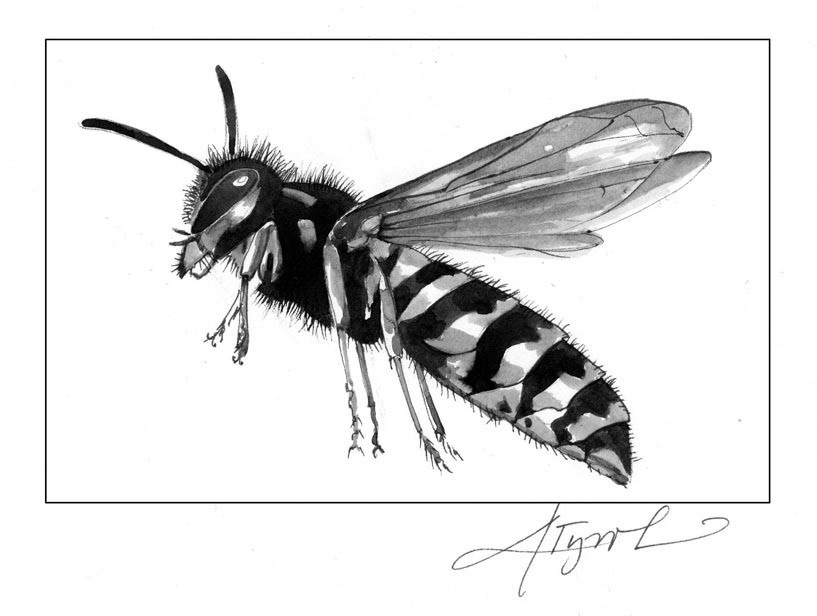
Looking out from the sun porch a few weeks ago, I noticed unusual activity near a sunlit corner of the house. Vespid wasps, better known as yellow jackets, were flying from a gap in the clapboards. Initially alarmed, I realized we had passed their nest entrance daily and not been attacked. Since we didn’t bother them, they didn’t bother us. They continued with their business.
Watching wasps from a distance is instructive. It’s also challenging, for I was attempting to photograph their mid-flight comings and goings. Magnification only seemed to increase their speed as I tried to follow them with my lens. When a photo captured their aerial acrobatics, I called out the “success” to timid souls watching from behind the screen door.
We know too well how hoards of yellow jackets can come boiling out of the ground when a lawnmower passes overhead. Female vespids have a potent stinger that they jab repeatedly when they believe that nest and young are threatened. Their dutiful response to disruption is understandable, even when they send us fleeing and howling in anguish.
Unlike the huge hanging nests of closely related paper wasps, the compact paper nests of yellow jackets are usually built in existing holes in the ground, in fallen logs or in low openings in buildings. Protected wall space under loose clapboards makes an appealing spot.
Work on a new nest begins in spring, with the arrival of an impregnated working female, who may have spent the winter in a log or under forest litter nearby. As the nest behind the clapboards takes shape, she begins laying eggs that in a week or so will hatch into larvae, most of which will become female workers. A very few of these females will mate with males much later in the summer.
The nest becomes larger as these workers take over the building project from the queen. They forage far afield for construction materials and assume nursemaid duties at home. The queen continues to lay eggs in the ever-increasing number of paper cells. The hungry larvae are fed fresh insect meat brought home by the workers. The workers themselves find their own nourishment by sipping nectar from flowers.
My photos attempt to capture a steady stream of returning wasps. Occasionally the cargo held in their powerful jaws is shredded plant fiber that they use to make their nest paper. More often it’s a moist lumpy mass, much larger than the wasp’s head, which consists of macerated insect and spider parts, including a leg here, eyes there, and body fragments well-chewed for the hungry larvae.
Things go smoothly around the nest’s entry, which looks like a busy airport with arrivals and departures seemingly directed by an unseen flight controller. The airfield is a narrow opening between two clapboards, the rounded edges of the top of the lower board serving as the short runway. I have never witnessed a collision or even a jostling bump between wasps zooming in and hurriedly departing from this restricted space.
Vespid females are almost but not quite identical in their vivid black and yellow markings. In close-up photographs an individual wasp often can be distinguished from others by slight variations in their black banding.
I see differences in their behavior too, especially when they are maneuvering to land or gather on the sill. Some photos show a few recognizable individuals repeatedly landing at one end of the sill, while others use the opposite end.
Their mastery of flight is impressive. When a wasp approaches the entry its legs are still tucked up in flight mode. It hovers an inch or two from the landing site, veering one way or another while seeking an unoccupied spot or waiting for another vespid to depart. As it nears the clapboard sill, its clawed yellow legs extend and splay outward in preparation for landing. There is nothing awkward about approach or landing. Once alighted, a wasp scurries into the crack.
When vespids have finished their work inside the nest, they return to the open sill, stopping to face out for a moment. Occasionally one pauses on the runway longer than most, as if resting before going back on duty.
Most leave with empty jaws, but occasionally a wasp readies for takeoff, carrying something white, perhaps a bit of the house’s foam insulation that was removed to provide more room for nest expansion—not good news.
With autumn’s chill now penetrating the formerly bustling nest under the clapboards, most of my vespid neighbors’ busy lives are done; the exception are the few females that happened to mate. They will soon leave the nest and find another location to spend the winter, perhaps a spot on the ground, under insulating leaf litter.
Come spring, one is likely to take off and look for a new home somewhere behind a few of our shingles.


Discussion *